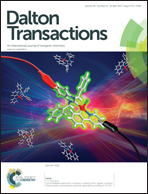Synthesis of a 12R-type hexagonal perovskite solid solution Sr3NdNb3−xTixO12−δ and the influence of acceptor doping on electrical properties
Abstract
A solid solution forms for Sr3NdNb3−xTixO12−δ with approximate limits 0 ≤ x ≤ 0.06. The system crystallizes with a 12R-type hexagonal perovskite structure in the space group R![[3 with combining macron]](https://www.rsc.org/images/entities/char_0033_0304.gif) , as determined by neutron diffraction and selected area electron diffraction. The electrical properties of the end members have been investigated by impedance spectroscopy in the temperature range 550–800 °C under various gas atmospheres and as a function of oxygen and water-vapour partial pressure. Proton transport dominates under wet oxidising conditions in the temperature range 550–700 °C, as confirmed by the H+/D+ isotope effect. Acceptor doping considerably enhances proton conductivity with a value of 3.3 × 10−6 S cm−1 for the bulk response of x = 0.06 at 700 °C in moistened air. The presence of a −¼ slope for both doped and undoped samples in the range 10−19 ≤ pO2 ≤ 10−8 atm at 900 °C indicates n-type transport under reducing conditions following the extrinsic model attributable to acceptor centres. The conductivity is essentially independent of pO2 at 600 °C under dry oxidising conditions, consistent with oxide-ion transport; a positive power-law dependence at higher temperature indicates extrinsic behaviour and a significant electron–hole contribution. The dielectric constant at RT of nominally stoichiometric Sr3NdNb3O12 is εr ∼ 37, with a moderately high quality factor of Q × f ∼ 16 400 GHz at fr ∼ 6.4 GHz. The temperature coefficient of resonant frequency of x = 0 is τf ∼ 12 ppm °C−1, which lowers to −3 ppm °C−1 for the Ti-doped phase x = 0.06.
, as determined by neutron diffraction and selected area electron diffraction. The electrical properties of the end members have been investigated by impedance spectroscopy in the temperature range 550–800 °C under various gas atmospheres and as a function of oxygen and water-vapour partial pressure. Proton transport dominates under wet oxidising conditions in the temperature range 550–700 °C, as confirmed by the H+/D+ isotope effect. Acceptor doping considerably enhances proton conductivity with a value of 3.3 × 10−6 S cm−1 for the bulk response of x = 0.06 at 700 °C in moistened air. The presence of a −¼ slope for both doped and undoped samples in the range 10−19 ≤ pO2 ≤ 10−8 atm at 900 °C indicates n-type transport under reducing conditions following the extrinsic model attributable to acceptor centres. The conductivity is essentially independent of pO2 at 600 °C under dry oxidising conditions, consistent with oxide-ion transport; a positive power-law dependence at higher temperature indicates extrinsic behaviour and a significant electron–hole contribution. The dielectric constant at RT of nominally stoichiometric Sr3NdNb3O12 is εr ∼ 37, with a moderately high quality factor of Q × f ∼ 16 400 GHz at fr ∼ 6.4 GHz. The temperature coefficient of resonant frequency of x = 0 is τf ∼ 12 ppm °C−1, which lowers to −3 ppm °C−1 for the Ti-doped phase x = 0.06.


 Please wait while we load your content...
Please wait while we load your content...